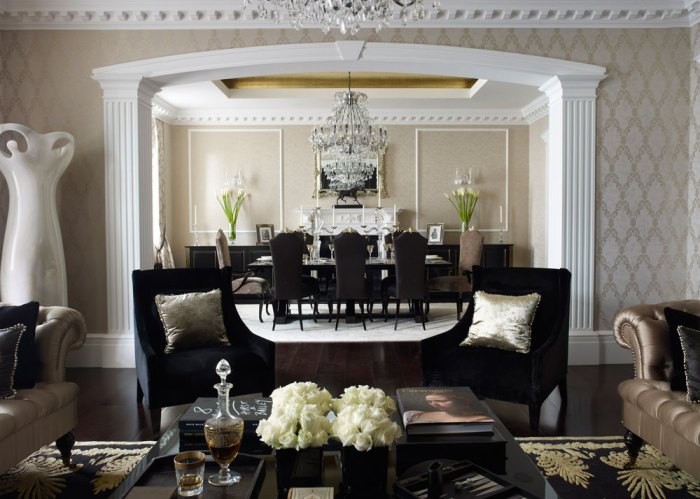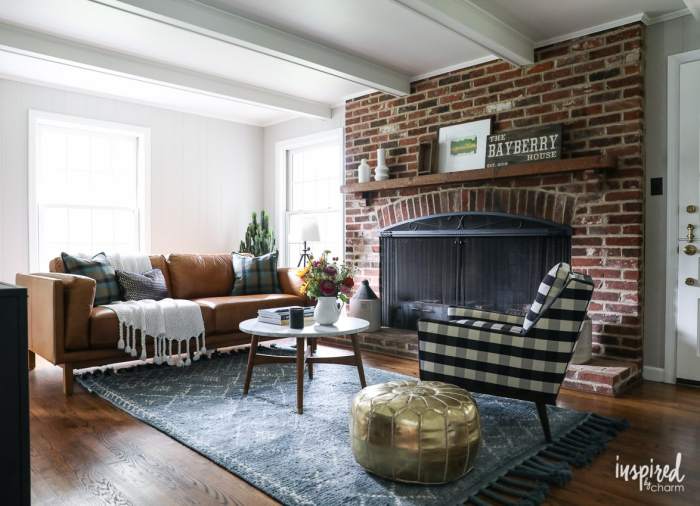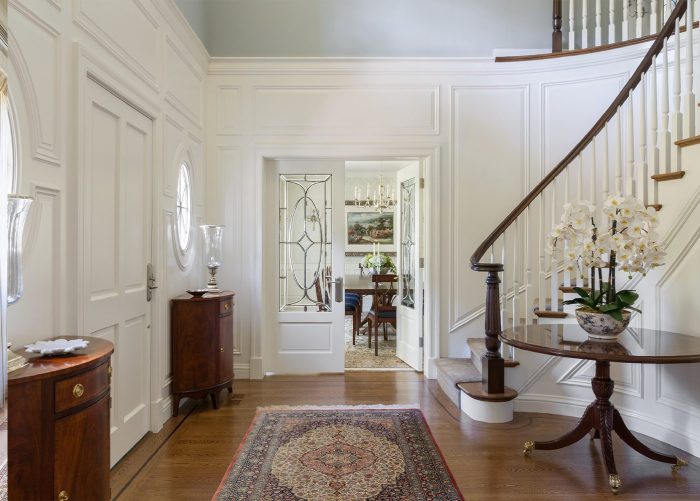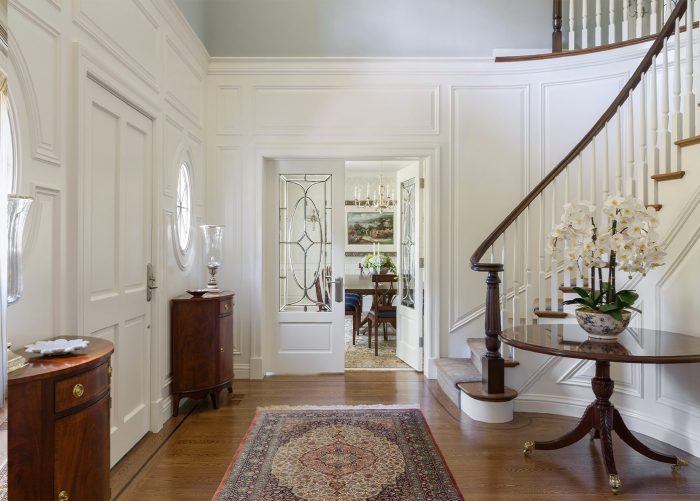Colonial house interior design evokes a sense of history and elegance, transporting us to a time when craftsmanship and attention to detail were paramount. This style, deeply rooted in the early American colonies, draws inspiration from European design trends, incorporating traditional materials and architectural elements to create inviting and functional spaces.
From the simple yet refined furnishings to the carefully chosen color palettes and patterns, colonial interiors tell a story of resilience, ingenuity, and the pursuit of comfort and beauty. Exploring this design aesthetic offers a glimpse into the lives of early Americans and their enduring legacy on modern design.
Lighting and Windows

Lighting and windows were crucial aspects of colonial house design, playing a vital role in both functionality and aesthetics. Colonial homes were designed to maximize natural light and ventilation, using a combination of innovative techniques and materials.
Lighting Methods
Colonial homes primarily relied on natural light, supplemented by various forms of artificial illumination. Here is a comparison of different lighting methods used in colonial homes:
| Lighting Method | Advantages | Disadvantages |
|---|---|---|
| Sunlight | Free, abundant, and provides natural warmth | Limited during the day, dependent on weather conditions |
| Candles | Portable, readily available, and create a warm ambiance | Produce smoke and soot, limited light output, and fire hazard |
| Oil Lamps | Brighter than candles, longer burning time | Produce smoke and soot, fire hazard, and require regular cleaning |
| Fireplaces | Provide heat and light, create a cozy atmosphere | Smoke and soot, fire hazard, and limited light distribution |
Window Designs
Colonial homes typically featured windows with multiple panes, often six or more, arranged in a grid pattern. These windows were designed to:
- Maximize natural light penetration
- Provide ventilation for air circulation
- Enhance the aesthetic appeal of the house
Window sashes were often made of wood, with shutters for added protection and privacy.
“Colonial windows were often designed with a combination of fixed and operable panes, allowing for controlled ventilation while maintaining structural integrity.”
Windows were typically placed strategically throughout the house, ensuring adequate light and air flow in every room. This was particularly important in the warmer months, when natural ventilation was essential for keeping homes cool.
Textiles and Fabrics
Textiles and fabrics played a crucial role in colonial interior design, adding color, texture, and warmth to homes. They were not only functional but also reflected the social status and personal taste of the inhabitants.
Materials Used for Curtains, Upholstery, and Bedding
The choice of materials for curtains, upholstery, and bedding varied depending on the availability and affordability of resources. Here are some common materials:
- Linen: Linen was a popular choice for curtains and bedding due to its durability, breathability, and ability to withstand frequent washing. It was often used in plain white or natural shades, but could also be dyed in various colors.
- Wool: Wool was used for upholstery and bedding, especially in colder climates. It provided warmth and insulation, and was often woven into thick, heavy fabrics like broadcloth or serge.
- Cotton: Cotton became more widely available in the 18th century, and was used for a variety of textiles, including curtains, upholstery, and bedding. It was softer and more affordable than linen, making it a popular choice for everyday use.
- Silk: Silk was a luxurious fabric that was often used for upholstery and curtains in wealthy homes. It was imported from Asia and was highly prized for its beauty and softness.
- Velvet: Velvet was another luxurious fabric that was used for upholstery and curtains. It was made from silk or wool and had a soft, plush texture.
Traditional Textile Patterns
Colonial textiles often featured traditional patterns that reflected the cultural heritage and artistic influences of the time. Some common patterns include:
- Chintz: Chintz is a printed cotton fabric that originated in India. It was characterized by bold floral patterns and vibrant colors.
- Damask: Damask is a woven fabric that features a raised pattern on one side and a different pattern on the other. It was often used for upholstery and curtains, and was typically made from linen, silk, or wool.
- Brocade: Brocade is a richly woven fabric that features intricate patterns of raised threads. It was often used for upholstery and curtains in wealthy homes.
- Needlepoint: Needlepoint is a type of embroidery that was used to create decorative textiles, such as cushions, rugs, and tapestries. It often featured geometric patterns or floral motifs.
Modern Interpretations: Colonial House Interior Design

Modern interior design often draws inspiration from historical styles, including colonial design. This fusion of old and new creates a unique aesthetic that is both timeless and contemporary. Modern designers incorporate elements of colonial style in contemporary homes, achieving a balance between traditional elegance and modern functionality.
Colonial house interior design often draws inspiration from the grand estates of Europe, with its ornate moldings, high ceilings, and a focus on symmetry. While colonial design emphasizes tradition, contemporary homes in India often blend traditional elements with modern aesthetics, creating a unique and vibrant style.
For those seeking inspiration for their own colonial-inspired interiors, a look at beautiful house interior design in India can offer a fresh perspective on blending old and new, incorporating local craftsmanship and cultural influences into a modern context.
Contemporary Homes Featuring Colonial Design Elements
Modern homes incorporating colonial design elements showcase a blend of classic and modern aesthetics. Here are a few examples:
- Farmhouse Revival:This style combines traditional colonial elements like exposed beams, wood paneling, and large windows with modern features like open floor plans and sleek finishes. The farmhouse revival style often uses natural materials like wood, stone, and metal, creating a warm and inviting atmosphere.
- Coastal Colonial:This style blends colonial elements with a relaxed coastal vibe. Homes often feature whitewashed walls, light wood floors, and nautical accents. The coastal colonial style emphasizes natural light and airy spaces, creating a sense of tranquility and connection to the outdoors.
- Urban Colonial:This style adapts colonial elements to a modern urban setting. Homes often feature traditional details like wainscoting, crown molding, and fireplaces, but with a more minimalist and streamlined approach. The urban colonial style uses contemporary materials and finishes, creating a sophisticated and refined aesthetic.
Colonial house interior design often evokes a sense of history and tradition, with its focus on warm wood tones, elegant moldings, and a touch of formality. However, even in a smaller space, you can achieve a similar aesthetic. If you’re looking for inspiration on how to create a charming and functional interior in a two-story home, check out this resource on 2 storey small house interior design.
You’ll find tips and ideas on maximizing space, incorporating classic elements, and creating a cozy and inviting atmosphere, all while maintaining the essence of colonial style.
Designing a Modern Living Room with Colonial Elements, Colonial house interior design
A modern living room incorporating key elements of colonial style can be achieved through a thoughtful selection of furniture, materials, and decor. Here’s how to create a harmonious blend of classic and contemporary:
- Furniture:Choose furniture pieces with clean lines and simple silhouettes, but with a touch of traditional elegance. Consider a comfortable sofa with tufted upholstery, a statement armchair with a classic design, and a coffee table with a rustic wood finish.
Colonial house interior design often embraces a sense of history and tradition, with elements like wainscoting, fireplaces, and built-in bookshelves. While these features are rooted in the past, they can be seamlessly blended with modern sensibilities. For example, a colonial house can be infused with a touch of Art Deco flair, drawing inspiration from the 1920s house interior design movement, which was known for its geometric patterns and bold colors.
This blend of old and new creates a unique and inviting atmosphere, showcasing the timeless appeal of colonial design while incorporating modern trends.
- Materials:Incorporate natural materials like wood, leather, and linen to create a warm and inviting atmosphere. Use wood floors, a leather armchair, and linen curtains to add a touch of colonial charm.
- Color Palette:Stick to a neutral color palette with pops of color. Use warm tones like cream, beige, and brown as the base, and add accents of blue, green, or red for a touch of vibrancy.
- Decor:Add colonial-inspired decor pieces like antique maps, vintage prints, or woven baskets. These elements add a touch of history and character to the space.
Closing Summary

As we delve into the rich history and captivating details of colonial house interior design, we discover a timeless style that continues to inspire and influence modern homes. By understanding the evolution of this design aesthetic, we can appreciate the enduring appeal of its simplicity, functionality, and inherent beauty.
Whether it’s incorporating a traditional fireplace mantel or embracing the warmth of a colonial color palette, elements of this design style can add a touch of history and charm to any contemporary space.
Q&A
What are some popular colonial house exterior styles?
Colonial houses are often associated with styles like Georgian, Federal, and Colonial Revival. Each style has its unique characteristics, such as symmetrical facades, detailed moldings, and specific window designs.
How can I achieve a colonial feel in a modern home?
You can incorporate colonial elements by using traditional furniture pieces, incorporating warm color palettes, adding architectural details like wainscoting or crown molding, and choosing fabrics with patterns inspired by colonial textiles.
What are some key differences between colonial house interior design in different regions?
Regional variations in colonial house interior design are influenced by local materials, climate, and cultural traditions. For example, houses in the South often feature verandas and lighter color palettes, while those in New England might incorporate darker woods and more intricate details.

